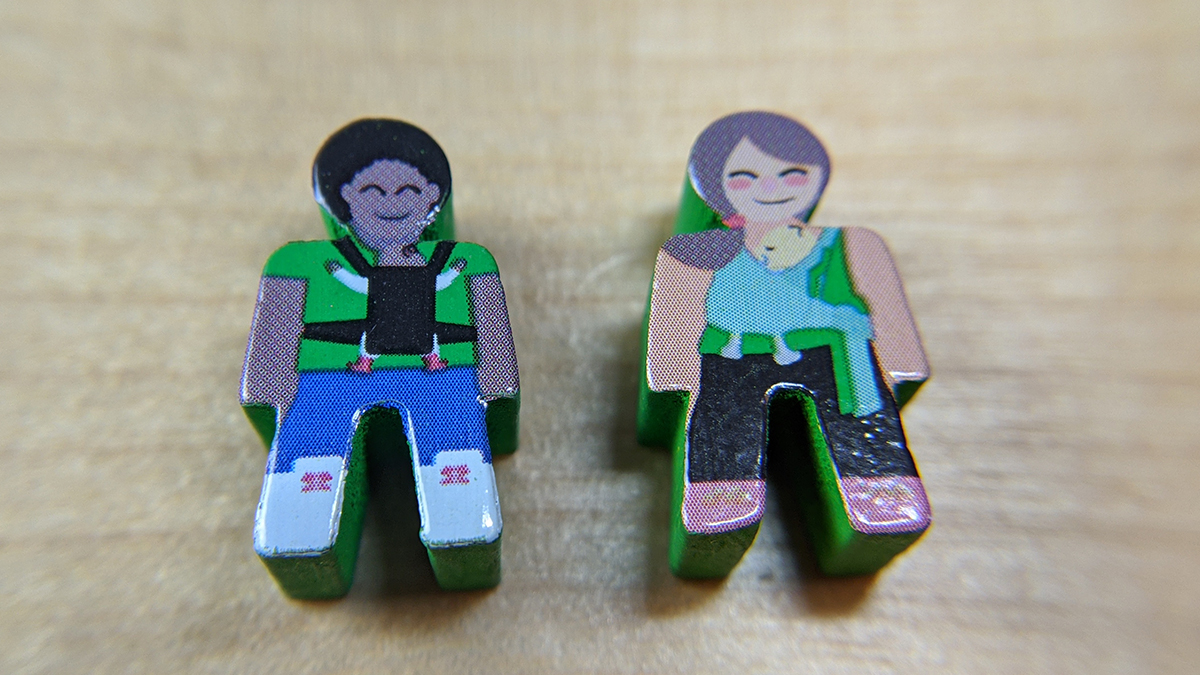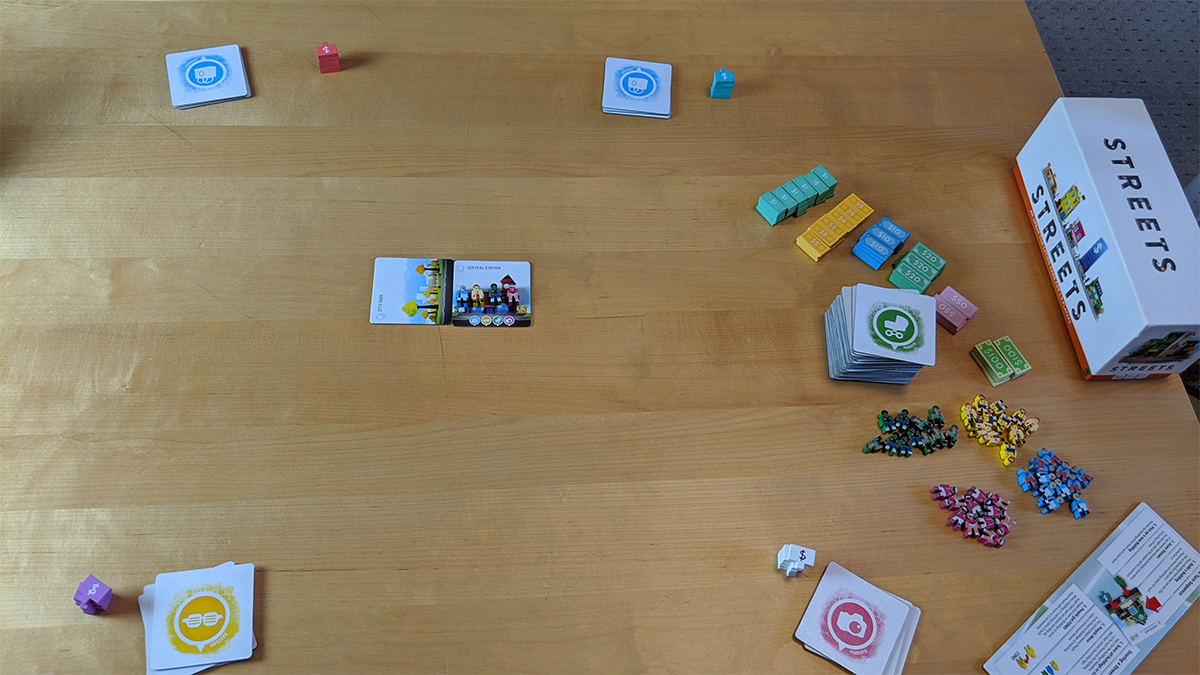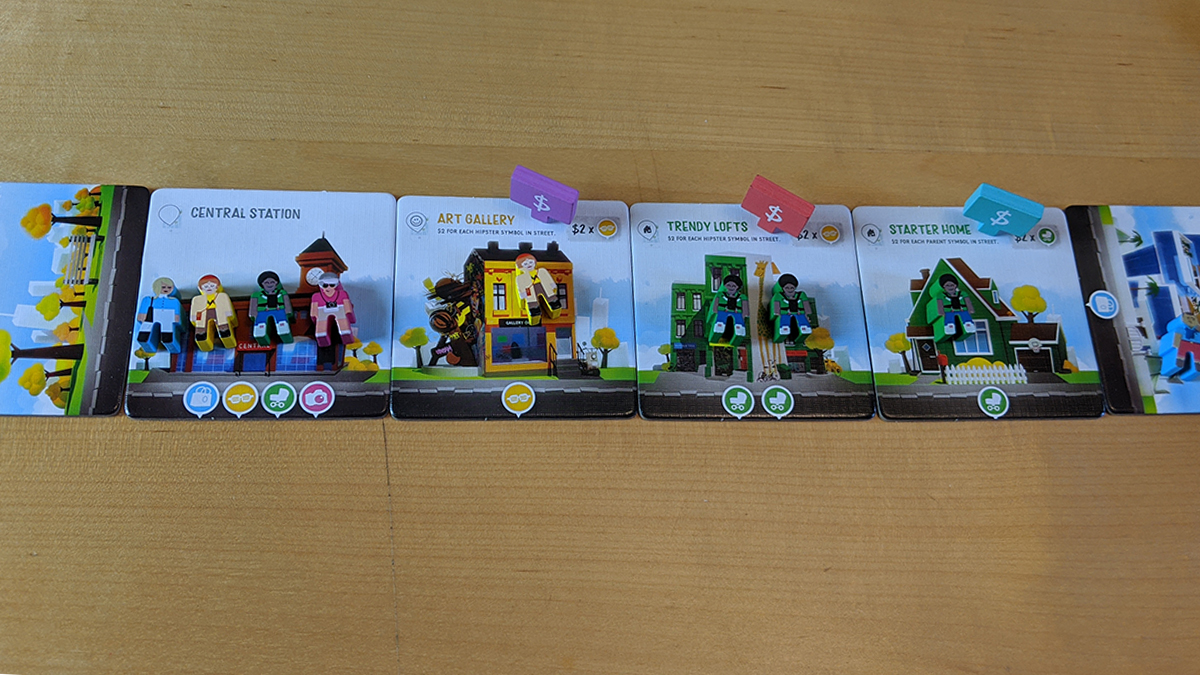Can you help others build the best city possible, while making the most money for yourself? That’s the basis of Streets, a new game on Kickstarter.
What Is Streets?
Streets is a game for 1-5 players, ages 10 and up, and takes about 30 minutes to play. It’s currently seeking funding on Kickstarter, with a pledge level of £23 (about $31) for a copy of the standard game, or £38 (about $51) for the deluxe game.
Streets was designed by Haakon Hoel Gaarder and published by Sinister Fish Games.
New to Kickstarter? Check out our crowdfunding primer.
Streets Components
Note: My review is based on a prototype copy of the game, so it is subject to change and may not reflect final component quality.

- 1 City Park tile
- 1 Central Station tile
- 40 building tiles
- 5 extra building tiles for the 5 player game
- 48 wooden people, 12 each in 4 colors
- 87 wooden money tiles, in various denominations from $1-$100
- 25 wooden ownership signs, 5 for each player
- 1 cardboard double-sided rules reference
- 48 wooden business tokens for the Business expansion
- 7 consultant cards for the Consultants expansion
The prototype I was sent for review is for the deluxe edition. According to the Kickstarter page, the standard edition has unpainted people, and cardboard tokens in place of the wooden money and business tokens shown below.
While I was reviewing a prototype, the game has the look and feel of a completed, polished version, so honestly I don’t expect the quality of the finished game to be too different from what I saw. And that would be completely OK, as the version I was sent would be well worth the purchase price.

The building tiles are all 2mm thick cardboard squares, 7 cm on a side (about 2.75 inches). Each is bright and colorfully screenprinted on both sides. The main side shows a building of some kind, with whimsical artwork, and all of the important game information pieces: an icon for the Business expansion, the valuation the building receives when the street is completed (which is shown in both icon form and printed, English text), and an icon to show both the number of people to be placed when the building is constructed and the color/category to which the building belongs. That all of this is crammed into the relative small space on the tile shows some real thought went into the design. Also, the design of the tiles meant that I did not have to keep going back to the rules to figure out what stuff meant; when we played the game, all of us figured out quite quickly what everything meant and were therefore able to learn the game in almost no time.

The backs of the tiles show which type of building the tile belongs to.

The wooden people were a particularly surprising component. For starters, they aren’t meeples. Now, don’t get me wrong–I like meeples. I bought a bunch of oversized ones at Gen Con a couple of years ago that are purely for display, and even sent my daughter to the real city of Carcassonne with a stuffed meeple. But that doesn’t mean that every game needs to include them, and it’s always a bit refreshing when I see a game that took the extra step to be a bit creative and come up with something new.

But what really surprised me about the people is that they were all very nicely screenprinted, so they weren’t just colored, semi-shapeless pieces of wood on the board. They’re all wearing clothes, and they’re actually pretty diverse–each color has is made up two different prints, half of which appear to be men and half women, and they are not all white people, either. (Note that the screenprinted people is a component only in the deluxe game. In the standard game, they all look the same save the color.)

The money tokens are another component that were nicer than I’m used to in prototypes. I’m on record as saying that I’d always prefer tokens to paper money in games, but wooden tokens up the ante to another level. And even beyond the wood (and again, the standard game has cardboard money), the care taken in the design here shows through, as each denomination is a different color and size (a feature of a lof of the money in a lot of countries that may come as a surprise to some Americans), which makes sorting and keeping track of the money very easy.

The ownership signs look like mini real estate signs. They come in five somewhat unusual colors–because yellow, pink, green, and blue were already used by the people, the ownership signs, which denote each player’s color, are purple, red, white, black, and teal green.

The rules reference is a longer cardboad tile with the basic information on one side and the information on how to play with the Business expansion on the other.

The Business expansion, which comes with the game and is accounted for on the tiles, is really more of an alternative set of rules for the game, which is nice. Playing with the expansion introduces the business tokens, which again are wood in the deluxe edition (and thus my prototype) and are cardboard in the standard version of the game.

The Consultants expansion, which feels much more like a traditional expansion, introuces the consultant cards, a set of information cards printed on heavy paper.
How to Play Streets
The Goal
The goal of the game is be the player with the most money when all of the tiles have been played.
Setup

To begin, place the City Park tile in the middle of the table. Then, place the Central Station tile perpendicular to the City Park tile, and place one of each color people on the Central Station tile.
Shuffle the 40 basic tiles. If playing with 2 players, remove 2 random buildings of each type. If playing with 3, remove one of each type. A 4 player game uses all of the basic tiles, and with 5 players, add in the five special tiles. Place the stack in a face-down pile, and then deal 3 tiles to each player.
Place the money and people tokens in everyone’s reach.
Each player takes the 5 ownership tiles of their color.
Gameplay

The first player plays one of the building tiles from their hand and places it in the city, along with one of their ownership signs and any people as indicated on the tile.

Rules for placing buildings are pretty straightforward: you need to place the building either so its street lines up with the street of the building next to it, or so that it is perpendicular to the tile(s) next to it, forming a new street. Pretty much the only thing you can’t do is place the tile so that the two streets are next to each other, forming a wider street.
Each tile has in its bottom center a small icon or icons that indicates the type of building it is, and the number of people to be placed on the building when it is built. These are all color-coded, so when placing a blue building with a single blue icon, you place a blue person there. If placing a buiildng with two yellow icons, you’d put two people on the tile. When placing people, always be sure to place them laying down (this is important.) Some tiles are wild, and do not get people.
Once the starting player is done placing their tile, they draw a new tile from the stack (you’ll always have three tiles in your hand until the end game), and the next person plays their turn.

The only variation to the game turn occurs when a street is completed by having both sides blocked off by perpendicular tiles. At this point, the street scores. Ther order of scoring generally doens’t matter too much. Each player who has a building on the now-enclosed street determines its valuation and receives payment from the back for it. There are ten types of valuations, all of which are indicated in the top right corner of the building and spelled out under the building’s name.

A number times a person icon means the owner of the building receives that number times the number of people on the street in the appropriate color. A number times a symbol means the player gets the indicated amount for each building matching that symbol. Wild buildings count as every symbol. A number times a symbol set grants the owner the number for each set of the indicated symbols, with each building only counting towards one set, but again, wilds can be used. The wild symbol nets the player the number of wild buildings on the street. Ownership signs give the player the indicated amount for each their ownership signs on the street, while a number with an open box gives them that number times the number of buildings on the street.
Adjacency is a tricky one, as the player scores the indicated amout for each other building surrounding the one being scored, not counting the building itself. It’s tricky because getting a building to have the maximum possible surrounding buildings without its street getting closed off and scoring too early can be tough. The enclosure award is a fixed $6 if this building is one of the two enclosing a street, and finally, the copy valuation lets you simply copy any other valuation on the street.

One more note on valuation: the icon for the type of building has a small arrow pointing down. If a building it used to enclose a street and its arrow points into the street, then it does count for the number of symbols on that street for valuations such as counting the number of symbols or for sets.
In addition to the valuation of the building itself, the player gets $1 for each person on the building. Once they have figured out how much the building it worth, they take the money from the bank and take their ownership sign back.
Once all of the buildings on the street have scored, the people need to move. The current player must move everyone on the street to buildings on other, non-enclosed streets, if possible. The rules here are, again, straight-forward: the people move to another building of the same color on a street that is not yet enclosed. If more than one option is available, the current player decides. People cannot move to buildings on enclosed streets, or to buildings that do not match their color or are wild.

If, as happens frequently, the people cannot move because no legal buildings exist, they get FOMO. The current player stands them up on their current tiles (this is why it’s important that they be placed laying down). As soon as a building is played on some subsequent turn that meets the criteria, all of those people will immediately move to that new building and place them laying down. This is in addition to any people that building would normally get.
If the current player has no ownership signs left, they must abandon a building they have already played by removing its ownership sign and placing it on the new building. This would mean that theydo not score for that building when the street finishes, but sometimes that’s okay, as it’s possible for buildings to end up scoring nothing anyway.
Game End
The game ends when the stack has been depleted and everyone has played all of the tiles from their hands. At this point, score any remaining buildings with ownership signs, but at half their normal valuation, rounded up. No people move in this final scoring round. The player with the most money wins.
Expansions
The Business expansion allows players to specialize in certain types of businesses and expand their profits. Each tile has a business icon in its top left corner. There are four types of businessed, plus a wild. During setup, you simply add the business tokens to the supply. However, during gameplay, an additional step is added when scoring streets: each player, before scoring anything, picks one type of business from the buildings they own on the street and takes the matching token. If they have more than one building with the selected business type, they take tokens for the number of buildings that match. If several players have several options as to which token they can take, players select in turn order, starting with the player next to the current player and allowing the current player to select last. If a building has a wild business icon, they can take any token of their choosing. If a buidling has to be abandoned, the player takes the matching business icon(s) when they abandon the building. Once a particular business type’s tokens run out, playes can no longer select that type, and future icons on buildings of that type are treated as wild.
At the end of the game, players get bonus money for their businesses. Whomever has the most tokens of a particular business type gets an extra $10. If two or more players are tied, they all get $5 each. And, for each set of four business type tokens, players get an additional $5.
The Consultants expansion introduces characters that give players special abilities. At setup, each player is dealt a random consultant card. Some cards are only used in certain player counts. Some also impact the game’s setup and should be handled right away.
Each consultant card grants to its player a special, ongoing ability, as printed on the card.
Solo Mode
Streets also includes a solo mode. To play, you set up the game according to the two-player rules (so, remove 10 random tiles.) You will play against the Grifter. Draw three tiles for yourself, and then randomly pull three tiles off the stack and place them facedown on the table for the Grifter. The Grifter takes all of the ownership tiles except the ones of the color you choose. You may also give the Grifter a starting back account to make the game harder. Finally, turn the stack face-up.
The turn order starts the same as the regular game: you build a buiding, and as needed score. However, after you place a building and possibly score a street, the Grifter gets a turn by building a tile and scoring streets.
Rules for placing tiles played by the Grifter follow those of the regular game, but the Grifter will always place a building to maximize its valuation. If the building has a Enclosing valuation, it must be placed so that it encloses a street, and if there are options, it’ll be placed where its enclosure will cause the most people to move.
Scoring streets works exactly the same as in the base game.
When the stack runs out, you will flip over the three tiles set aside at the beginning of the game and play through them as the Grifter’s final three turns. Just as in the regular game, you win if you have more money than your opponent (the Grifter.)
Why You Should Play Streets
We found Streets to be a light, fun game. While there is certainly strategy–figuring out now just where, but when to play your tiles definitely makes this a thinking person’s game–it’s not a heavy game by any means.
When I first opened the box, I surprised by how few tiles there were. I’m using to tile laying game having closer to, if not over, 100 tiles. But then we played it and it turns out the number is just right. Not only does it keep the game shorter, but if there were dramatically more tiles, a lot of the strategy would start to get lost, as you’d really have time to develop longer plays. As it is, if you hold on to a tile until the timing is just right, you may find that the game is suddenly ending and you can’t score much at all.
It also has a lot of interaction. The fact that everyone is building the same city gives lots of opportunities to sabotage other players. In our first game, my son played a tile that would score based on the number of tiles on a street, and I then promptly enclosed the street to prevent him from gaining more points.
And then there are the people. Fairly quickly, you’re going to end up with masses of people moving together, as the nature of having people on streets that have scored move to unscored streets will naturally cause them to start grouping. And that again exposes another strategy–do I enclose a street and score a building, even if it means the only place the people can go is to one of my opponent’s buildings, or do I try to wait and hope I can play a building of the right color and get at lest some of those people?
Streets is beautifully designed and well-thought-out. I suspect it’s going to become a fairly common warm-up game if I ever get to start having game nights again. I’ll be backing in on Kickstarter, and think you should, too.
For more information or to make a pledge, visit the Kickstarter page!
Click here to see all our tabletop game reviews.
![]() To subscribe to GeekDad’s tabletop gaming coverage, please copy this link and add it to your RSS reader.
To subscribe to GeekDad’s tabletop gaming coverage, please copy this link and add it to your RSS reader.
Disclosure: GeekDad received a copy of this game for review purposes.





